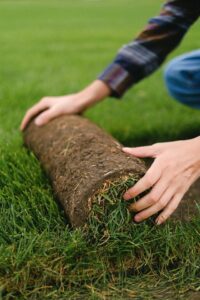 A quality lawn should have a more or less uniform thickness (2-4 cm), be recently trimmed, and have a good even colour without large bald spots. There should be no noticeable pests or external signs of disease. A minimum number of weeds is allowed – up to two per 50 square meters of product. A dense, high-quality lawn should have at least one stem per square centimetre. Pay attention to the soil from the inside – normally, it should not contain stones, excess clay or sand. The roots must be developed, and thanks to them, the plants will be anchored in the soil to obtain water and mineral nutrition. The presence of a sufficient number of white roots indicates the good condition of the root system. You should not buy a lawn with a musty smell and yellowed areas. Before purchasing, you must roll and unroll the roll several times; a quality product will not tear or crumble. –
A quality lawn should have a more or less uniform thickness (2-4 cm), be recently trimmed, and have a good even colour without large bald spots. There should be no noticeable pests or external signs of disease. A minimum number of weeds is allowed – up to two per 50 square meters of product. A dense, high-quality lawn should have at least one stem per square centimetre. Pay attention to the soil from the inside – normally, it should not contain stones, excess clay or sand. The roots must be developed, and thanks to them, the plants will be anchored in the soil to obtain water and mineral nutrition. The presence of a sufficient number of white roots indicates the good condition of the root system. You should not buy a lawn with a musty smell and yellowed areas. Before purchasing, you must roll and unroll the roll several times; a quality product will not tear or crumble. –
Manufacturing Of Rolled Turf
To grow a rolled lawn, grass seeds are sown at close intervals on a special base made of synthetic or plant fibre to ensure the density of the turf. Before being ready for sale, such a lawn grows for at least two years. Lawn grasses are most often represented by field and meadow grasses. Quality lawns should include bluegrass (poa grass) and fescue grass (fescue grass). Thinlegged (the name bluegrass is often found on sale) has high decorative and technical qualities, grows slowly, forms a dense turf, and provides a rich green colour. The brome (fescue) leaves quickly but grows slowly. It is unpretentious and grows in different conditions – in the shade and the sun; it is well suited for those who want to spend less effort and time caring for their lawn. Another common component of lawns ryegrass, which grows quickly, has a high density, is resistant to mowing, and has shiny leaves with a rich colour. But its maximum growth occurs in the first year, so you cannot buy lawns consisting only of ryegrass – after a few years, they lose their appearance. Less commonly, lawn mixtures include timothy, brooms (bentgrass), and comb. Sometimes legumes are used – clover or alfalfa; they have high decorative qualities and are unpretentious to external conditions, but only some people like the appearance of such a lawn. Different types of rolled lawns are on sale – universal, shady, and premium. They differ in the decorative properties of grass varieties. In shady varieties, the percentage of fescue, which is less demanding in growth conditions, is increased, but in this case, the resistance to trampling that bluegrass provides is reduced.
Uses Of Rolled Grass
Grass sods are frequently used in garden areas, and grass maintenance is normally included in the price of maintaining a garden, so hiring a professional in these cases can be profitable. However, grass sod can have many applications in addition to this:
- To begin with, as we have already mentioned, it is very common to put grass sod in gardens and pool areas, especially in homes. Depending on the surface you want to cover, larger or smaller grass rolls can be used.
- We have also talked about the use of sod in the sports field. Specifically, it is very common for this type of natural grass to be used on soccer fields, golfcourses and even racetracks due to the speed with which it can be planted and used.
- Parks or public gardens sometimes take advantage of natural grass in rolls.
- Finally, grass sods can also be used in trade fair stands and for commercial purposes.
